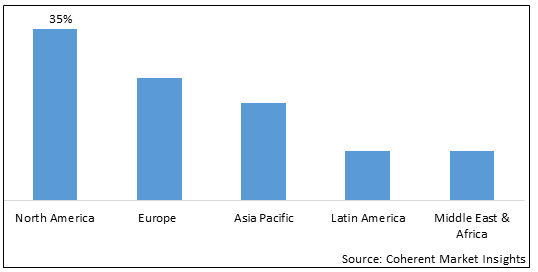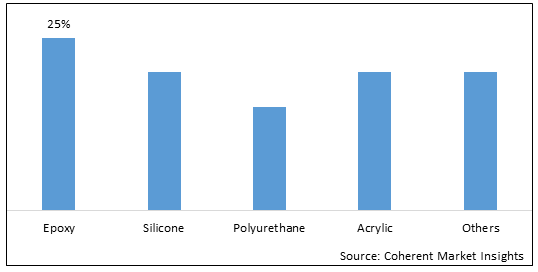
Radio Frequency Transmitter Encapsulant Market is estimated to be valued at USD 2.82 Bn in 2025 and is expected to reach USD 4.1 Bn in 2032, exhibiting a compound annual growth rate (CAGR) of 5.5% from 2025 to 2032.
The increasing demand for radio frequency (RF) transmitters in various applications, such as wireless communication, medical, and industrial, is driving the growth of the RF transmitter encapsulant market. RF transmitters are used to transmit and receive radio waves. They are used in a variety of applications, such as wireless communication, medical, and industrial. The increasing demand for these applications is driving the growth of the RF transmitter encapsulant market.
Radio Frequency Transmitter Encapsulant Market Regional Insights
Figure 1. Global Radio Frequency Transmitter Encapsulant Market Share (%), by Region, 2025

To learn more about this report, Download Free Sample
Radio Frequency Transmitter Encapsulant Market Drivers
Radio Frequency Transmitter Encapsulant Market Opportunities
Radio Frequency Transmitter Encapsulant Market Trends
Radio Frequency Transmitter Encapsulant Market Report Coverage
| Report Coverage | Details | ||
|---|---|---|---|
| Base Year: | 2024 | Market Size in 2025: | USD 2.82 Bn |
| Historical Data for: | 2020 To 2024 | Forecast Period: | 2025 To 2032 |
| Forecast Period 2025 to 2032 CAGR: | 5.5% | 2032 Value Projection: | USD 4.1 Bn |
| Geographies covered: |
|
||
| Segments covered: |
|
||
| Companies covered: |
Dow, Henkel, BASF, Nordson, LORD Corporation, H.B. Fuller, Siltech Corporation, Qualcomm, Broadcom, Skyworks Solutions, Qorvo |
||
| Growth Drivers: |
|
||
| Restraints & Challenges: |
|
||
Uncover macros and micros vetted on 75+ parameters: Get instant access to report
Radio Frequency Transmitter Encapsulant Market Restraints
Counterbalance: The development of new, cost-effective materials might help to reduce the cost of encapsulants and improve the performance of RF transmitters. Innovations in polymers, resins, or nanomaterial could allow encapsulants to provide superior protection at a lower cost
Analyst view:
The global radio frequency transmitter encapsulant market is expected to witness steady growth over the forecast period. The rising adoption of 5G infrastructure across major economies is a key driver augmenting demand for RF encapsulants. 5G networks require more transmitters and antennas than previous generations, which will boost the consumption of encapsulant materials for insulation and protection of RF components. Additionally, increasing internet penetration coupled with burgeoning data consumption is accelerating the need for network connectivity and capacity upgrades, thereby working in favor of the market. However, stringent environmental regulations regarding the use of hazardous materials in encapsulants threaten to impede the market expansion. Encapsulant manufacturers face the challenge of developing environment-friendly alternatives without compromising on technical performance. The Asia Pacific region currently dominates the global market and is anticipated to maintain its lead throughout the forecast period. This is attributed to the rising investments by countries like China and India in establishing advanced 5G networks. North America is also expected to present lucrative opportunities, supported by ongoing 4G upgrades and 5G deployments across various industries.
Key players must invest in clean material technologies to navigate evolving sustainability norms. Asia Pacific's continuing dominance also presents opportunities for regional market participants to capture increasing demand.
Recent Developments
New product launches
Acquisition and partnerships
Figure 2. Global Radio Frequency Transmitter Encapsulant Market Share (%), by Material Type, 2025

To learn more about this report, Download Free Sample
Top companies in Radio Frequency Transmitter Encapsulant Market
Definition: The radio frequency (RF) transmitter encapsulant market comprises materials and technologies used to protect and secure RF transmitters from environmental factors and to ensure their reliable operation. Encapsulants are specialized compounds that are typically used to encase electronic components to protect them from moisture, dust, chemical contaminants, mechanical shock, and vibration, which are particularly important in the case of RF transmitters used in various communications equipment. RF transmitter encapsulants are designed to have excellent electrical properties, such as low dielectric constant and low loss factor, to minimize any interference with the radio frequency signals being transmitted. They also need to have good thermal properties to dissipate the heat generated by the transmitters. The encapsulant materials used in RF transmitters could range from traditional epoxies and silicones to more advanced polymer compounds that offer enhanced performance characteristics. The market for RF transmitter encapsulants would likely be driven by the growth in the RF components market, which is in turn propelled by the increasing demand for wireless communication devices, the expansion of network infrastructure, the development of 5G technology, and the broader trends in the electronics industry towards miniaturization and reliability.
Share
Share
About Author
Vidyesh Swar is a seasoned Consultant with a diverse background in market research and business consulting. With over 6 years of experience, Vidyesh has established a strong reputation for his proficiency in market estimations, supplier landscape analysis, and market share assessments for tailored research solution. Using his deep industry knowledge and analytical skills, he provides valuable insights and strategic recommendations, enabling clients to make informed decisions and navigate complex business landscapes.
Missing comfort of reading report in your local language? Find your preferred language :
Transform your Strategy with Exclusive Trending Reports :
Frequently Asked Questions
Select a License Type
Joining thousands of companies around the world committed to making the Excellent Business Solutions.
View All Our Clients